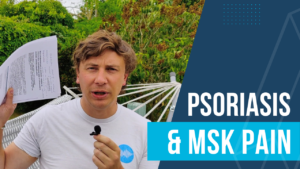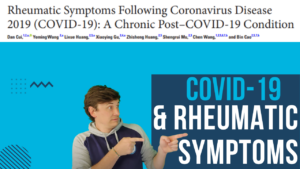Intro
Imaging in Rheumatology is a vital modality in assisting with the diagnosis and ongoing monitoring of the conditions. This blog begins another series of blogs which will aim to unpack imaging in Rheumatology from the perspective of Physiotherapists. It is clearly important that we utilise the imaging appropriately but also understand where our role lays in ensuring appropriate patients reach Rheumatologists in a timely fashion. Please head to blog one if you haven’t read that one yet here.
This second blog looks more deeply at MRI for AxSpA. Cards on the table… I am a Physio NOT a Radiologist/Rheumatologist and as such I have simplified some of the points so that it is (in my opinion) more appropriate for Physios and more importantly so my brain doesn’t melt out of my ears. So please remember that point when reading! Secondly please remember that the diagnosis of AxSpA MUST be made by a Rheumatologist.
Again, for the purposes of simplicity, we will be assuming that the attending patients are clear for red flag pathology. As usual feedback is greatly appreciated and any further reading for me please send it my way!
PLEASE REMEMBER – THIS BLOG IS NOT A REPLACEMENT FOR CLINICAL REASONING, IF YOU ARE UNSURE GET ADVICE
MRI for AxSpA
MRI is the gold standard imaging to assess for inflammatory lesions in a person suspected of having a Spondyloarthropathy. Remember that this is an umbrella term covering a number of specific diagnoses. Dependent upon the presenting symptoms, spinal MRI may not be the immediate choice. Significant peripheral synovitis for example may be a better target with diagnostic ultrasound. If MRI is the modality of choice it is important to request the correct sequencing so that we gain the information we need!
Imaging Protocol
In order to interpret the images appropriately for AxSpA the correct images are necessary. This is a combination of T1 weighted AND fat supressed sequences (such as STIR). These are required for side by side assessment of the images.
Imaging of both the SIJs in the coronal plane and sagittal images of the whole spine is recommended. Note that most if not all radiology departments will have a set up “SpA protocol” for MRI scanning. I would definitely advocate liasing with them prior to referral.
Example MRI referral – Suspected Spondyloarthritis, coronal images of SIJs, sagittal images of whole spine, please include T1 and STIR sequences.
Interpretation
The more lesions that are present the more diagnostic confidence can be applied to the MRI, the lesions may be limited to just the SIJs or the spine but can be spread throughout the axial skeleton. In the SIJs there may be oedema, fatty infiltration, erosions or a combination of features. In the spine inflammatory corner or fatty corner lesions of sufficient number are necessary to increase diagnostic certainty. Clearly new bone formation such as SIJ fusion or syndesmophytes in the spine greatly increase the likelihood of SpA.
MRI is not sufficient to diagnose AxSpA regardless of the presenting changes. It must combine symptoms, objective findings and blood results.
I have been lucky enough to attend a couple of workshops with Dr Alex Bennett who explains the whole process of interpretation brilliantly and if you can manage to get yourself to an event where he is doing this it is time worth its weight in gold! Check out the references for further in depth reading on this subject.
Further blogs
I will finish this series off looking at diagnostic ultrasound. I hope that you find it useful (if a little technical) it’s a fascinating developing area as our medical colleagues look to see if they can use it to predict outcomes and/or response to medications. I would love to hear your feedback and any further reading for me!
As usual thanks for reading and don’t forget to check out my other blogs. Sign up for the Rheumatology.Physio newsletter for further resources and updates!
Related Blogs
Imaging In Rheumatology for Physios
An Introduction to Rheumatoid Arthritis for Therapists
Inflammatory Arthropathy Bloods
References
Robinson, P.C., Sengupta, R. & Siebert, S. Non-Radiographic Axial Spondyloarthritis (nr-axSpA): Advances in Classification, Imaging and Therapy Rheumatol Ther (2019).
Alexander N. Bennett, Helena Marzo-Ortega, Amer Rehman, Paul Emery, Dennis McGonagle, on behalf of the Leeds Spondyloarthropathy Group; The evidence for whole-spine MRI in the assessment of axial spondyloarthropathy. Rheumatology (Oxford) 2010; 49 (3): 426-432.
Bray, A. Jones, M.A. Hall-Craggs, A. Bennett, P.G. Conaghan, A. Grainger, R. Hodgson, C. Hutchinson, M. Leandro, P. Mandl, D. McGonagle, P. O’Connor, R. Sengupta, M. Thomas, A. Toms, N. Winn, H. Marzo-Ortega, P.M. Machado. MRI Working Group, British Society for Spondyloarthritis, BRITSA, UK
Lambert RGW, Bakker PAC, van der Heijde D, et al. Defining active sacroiliitis on MRI for classification of axial spondyloarthritis: update by the ASAS MRI working group Ann Rheum Dis 2016;0:1–6 (really nice pictures!)


